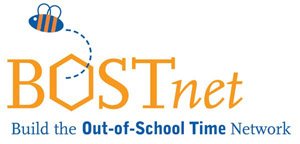The BOSTnet Inclusion Roundtable brought together a small number of program directors, direct care staff, and Inclusion specialists. The presentation initiated a great deal of conversation around the sorts of supports that Out-of-School Time can offer children and youth with disabilities and the need for increased funding of staff development to ensure that programs can provide a quality environment.
What was interesting was that unlike the last roundtable, this group did not say that they lacked the same supports as the school day because they questioned the supports of the school day itself. One support was the "one-to-one aide." It is common to hear many Out-of-School professionals mention that children they include in their programs are done so without the support of these aides and this reduces the quality of their program both for the individual who requires the support by day and for the other program participants. At the Roundtable, many questioned whether the aide model was good for the child in school or whether it set that child apart and allowed teachers and students to remove themselves from care-giving. One OST program staff said that it was a good thing that they did not have aides and that these children who were provided aides or sent to special programs within the school for the majority of the academic day were included in an authentic way during their program time (some mentioned that severe mobility impairment or intense mental or cognitive disabilities that lead to aggressive behavior may need additional supports). This was an interesting to hear since it is very common to hear lists of program challenges around Inclusion rather than a confident point of view that said "schools should learn from us about what we do" rather than "we are deficient in this area without funding."
There was a great deal of talk about how many schools continue to exclude children and youth with disabilities - and that these programs while they may not take place during the entire day are often in re-purposed areas of the school facility; basements, former bathrooms, former closets, former mechanical rooms. While many said that their programs operated in less-than-optimal facility environments, many programs felt that their program did a better job of including children or youth with special needs so that the physical space did not move these members of the community "out of sight." Some of the attendees had personal experiences with the Special Education system and spoke directly of being in a "closet classroom." One staff member said that he was diagnosed with a learning disability while the school support staff never questioned why he had missed so much school in the previous years. So the issue treated was the inability to read "on grade level" not the social issue of truancy. He claimed that this experience of being in Special Education classes increased his difficulties with school rather than elevating them - the primary reason being social/emotional not whether the mechanics of reading were being taught in a different way. His ability to be excepted by peers was impacted as well as self esteem. Another attendee picked up this thread and asked how it was that schools seem to teach exclusion during the day and then leave it to programs to "un-teach" what they have done. "We have to much to do in just a few short hours... We got to show them a different point of view than their school... maybe their family... has on children with special needs" a staff from an arts program exclaimed. "Well, all children have special needs" another staff chimed in. "We have to see that the modifications we make benefit all the children in the program.... I mean, we do this for everyone, not to accommodate only a few."
In all, the Roundtable only briefly touched on the formal presentation. One highlight of the presentation was a short discussion of Dr. Gary Siperstein's work on Inclusion and his thoughts that Out-of-School Time programs actually are bridging the social barriers between children of different abilities and do so because the environments of these programs are focused on relationships first, activities second, and have a flexibility that many formal settings do not have (one example was a program that was in an old building so that mobility impaired children could only attend the basement. The program did not have money to get in an elevator, so they moved the most popular activities - media and computers - to the basement. This created a situation where youth who wanted to access the resources needed to confront the Inclusive nature of the program. One girl was so unfamiliar with interacting with others in wheelchairs that she refused to come in but would stand at the door. By having discussions and allowing interactions to grow organically, this child finally entered the room and got rid of her fears while the program developed a culture of Inclusion that remains to today).
It appears that while there remain challenges (especially around having funding for quality professional development) there is perhaps an emerging attitude of many program staff that they are able to provide a very high quality of service - even if that service does not look like solutions provided during the school-day. While research and the voices from the field tell us that Out-of-School Time is providing Inclusive environments, these programs in the room felt that they were not recognized for the work that they did or the successes they were having.
16 years ago




No comments:
Post a Comment